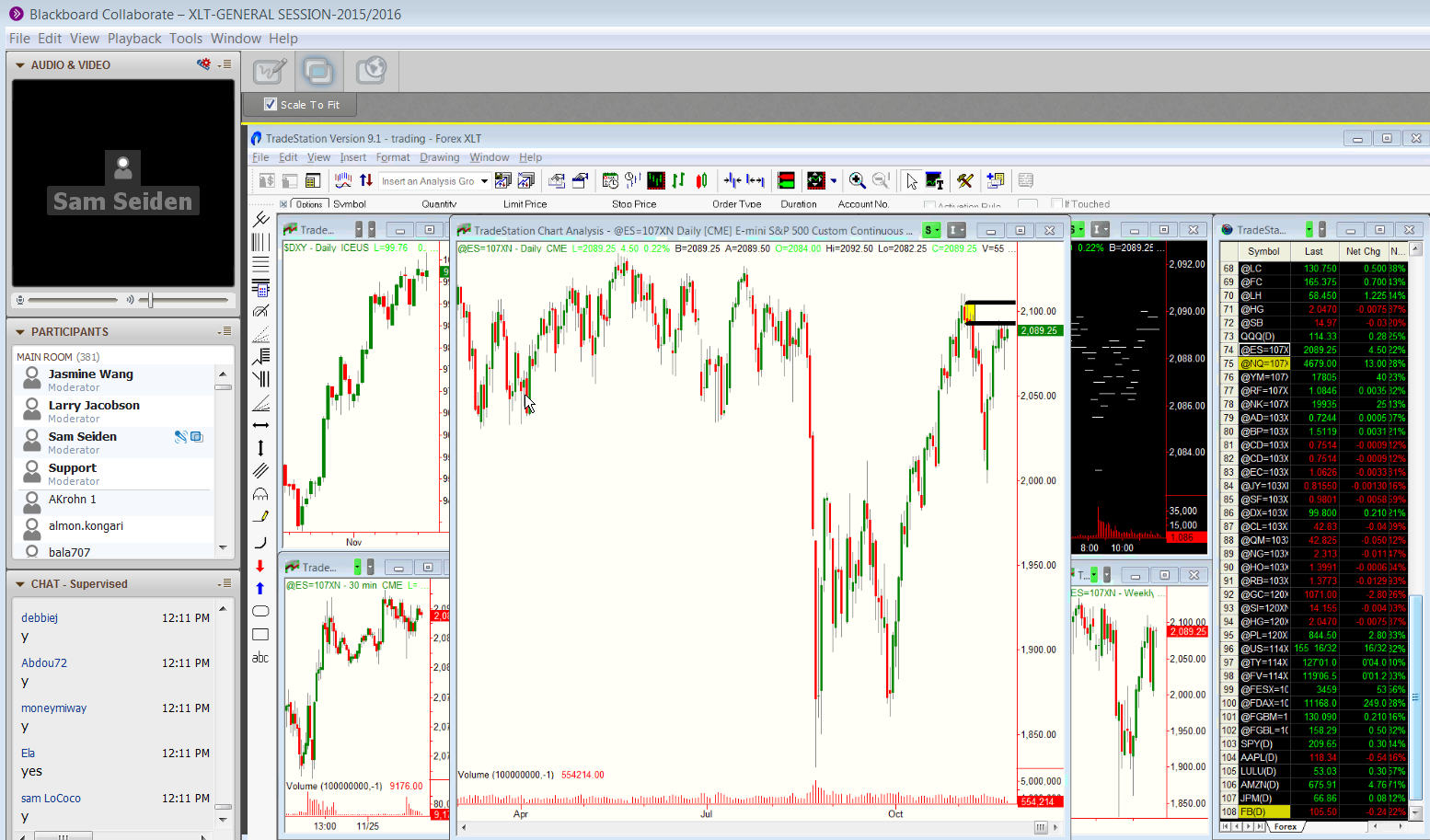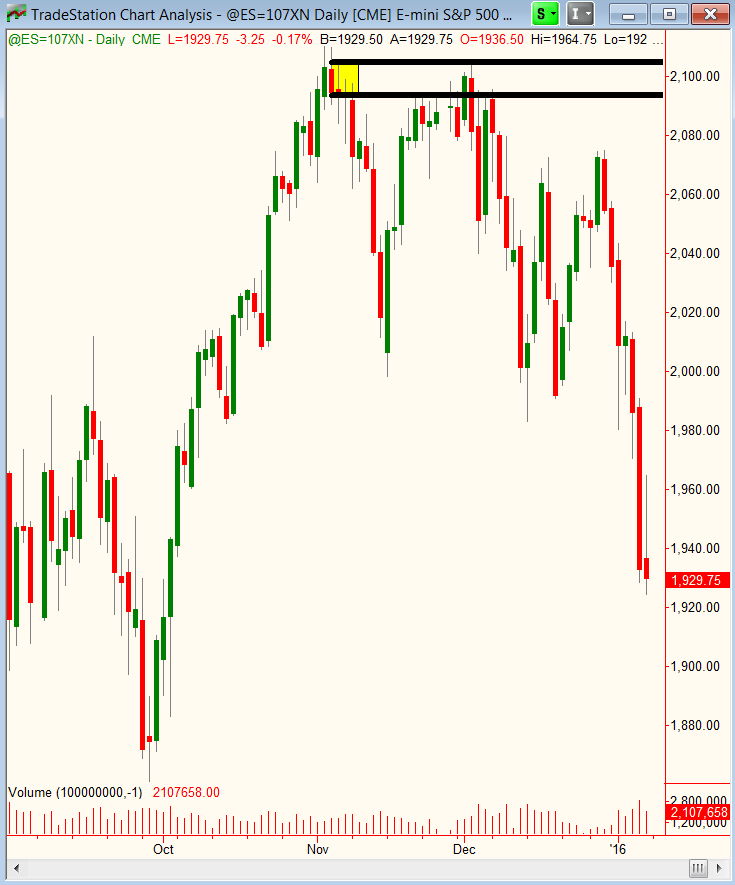![]()
I have been in the trading and investing business for nearly 20 years as a trader, fund manager, author and educator, beginning on the floor of the Chicago Mercantile Exchange. If I had to list the top three mistakes I see most traders make, one that would for sure be on the list is when people enter the market. Most traders today still buy when news is good and prices are up and sell when news is bad and prices are down. This is the single biggest reason Wall Street makes so much money and the average investor doesn’t. I will use a market setup I went over in one of our live market coaching sessions with our students to illustrate how this works.
Before getting into the details of the mistake and correcting it, it’s important to understand two key components of markets that you invest your hard earned money in.
Why do prices move in any market? Price in any market turns at price levels where demand and supply are out of balance. The consistently profitable market speculator is able to identify a demand and supply imbalance, which means knowing where banks and institutions are buying and selling in a market. By quantifying institution demand and supply areas on a price chart, you can identify market turns and market moves in advance with a very high degree of accuracy.
Who is on the other side of your trade? Market speculating (trading and investing) is simply a transfer of accounts from those who don’t know what they are doing into the accounts of those who do. The consistently profitable speculator knows that a novice is on the other side of their trades. Profitable traders and investors know to buy at wholesale prices (demand) and sell at retail prices (supply). This means they are good at identifying people who buy at retail and sell at wholesale by looking at a price chart.
The Retail Investor Mistake
Notice the screen shot below. This was a live trading session I was holding with about 300 students and we were looking at the S&P, one of the biggest and most important equity index markets in the world. At the time, the global stock markets like the S&P were near all-time highs, news was good and the trend was up. This meant most investors were buying, but was this the right thing to do? As you can see from the chart, I was going over the professional perspective, not the retail investor point of view. The chart was telling us the price had rallied to a level where supply greatly exceeded demand; banks were selling in that area. I knew this because of two things: first, that was an area of supply because price could not remain at that level and fell strongly. This can only happen when supply exceeds demand. Following our rules at Online Trading Academy, that supply level was VERY strong. Second, when price rallied back to that level we knew that novice investors were buying and, like Wall Street, we want to sell to that group as they are paying retail prices and unfortunately don’t know it. The novice investor was making two key mistakes that all novice market speculators make. First, they were buying after a period of buying and second, they were buying at a price level where supply exceeds demand. The chart told us that almost a month before that novice group bought at supply.
S&P Setup: 11/25/15
The Action
Given the strong supply level and the huge profit zone below, the action we took was to sell either by taking a short position or a bearish options position, which is what I did. Why would someone buy from us up there when price rallied to supply? The news was good and the trend in price was up, that is very attractive to most investors around the world. After all, that is when people are taught to buy into markets.
S&P Result: 1/8/16
The S&P ended up falling over 175 points from our supply level which is a huge move for the S&P. This can be very frustrating for the average investor because they are simply buying when they are told to buy, following conventional wisdom and education. The proper time to buy in any market and any time frame is at demand (wholesale) and sell at supply (retail). A key component to making this work that is beyond the scope of this article is this: When taking any buy or sell entries in markets, make sure you know exactly where price is with regard to larger time frame supply/demand. Whether you trade Stocks, Futures, Forex or Options, understand that behind all the candles on your screen in all these markets are people and their emotional decisions and banks with their logical buy and sell decisions. Learn to see the difference on a price chart and join the group that is consistently profitable. This is one of the most common mistakes I see investors make; they buy high and sell low.
Hope this was helpful. Have a great day.
Note: All information on this page is subject to change. The use of this website constitutes acceptance of our user agreement. Please read our privacy policy and legal disclaimer. Opinions expressed at FXstreet.com are those of the individual authors and do not necessarily represent the opinion of FXstreet.com or its management. Risk Disclosure: Trading foreign exchange on margin carries a high level of risk, and may not be suitable for all investors. The high degree of leverage can work against you as well as for you. Before deciding to invest in foreign exchange you should carefully consider your investment objectives, level of experience, and risk appetite. The possibility exists that you could sustain a loss of some or all of your initial investment and therefore you should not invest money that you cannot afford to lose. You should be aware of all the risks associated with foreign exchange trading, and seek advice from an independent financial advisor if you have any doubts.
Editors’ Picks
AUD/USD posts gain, yet dive below 0.6500 amid Aussie CPI, ahead of US GDP

The Aussie Dollar finished Wednesday’s session with decent gains of 0.15% against the US Dollar, yet it retreated from weekly highs of 0.6529, which it hit after a hotter-than-expected inflation report. As the Asian session begins, the AUD/USD trades around 0.6495.
USD/JPY finds its highest bids since 1990, approaches 156.00

USD/JPY broke into its highest chart territory since June of 1990 on Wednesday, peaking near 155.40 for the first time in 34 years as the Japanese Yen continues to tumble across the broad FX market.
Gold stays firm amid higher US yields as traders await US GDP data

Gold recovers from recent losses, buoyed by market interest despite a stronger US Dollar and higher US Treasury yields. De-escalation of Middle East tensions contributed to increased market stability, denting the appetite for Gold buying.
Ethereum suffers slight pullback, Hong Kong spot ETH ETFs to begin trading on April 30

Ethereum suffered a brief decline on Wednesday afternoon despite increased accumulation from whales. This follows Ethereum restaking protocol Renzo restaked ETH crashing from its 1:1 peg with ETH and increased activities surrounding spot Ethereum ETFs.
Dow Jones Industrial Average hesitates on Wednesday as markets wait for key US data

The DJIA stumbled on Wednesday, falling from recent highs near 38,550.00 as investors ease off of Tuesday’s risk appetite. The index recovered as US data continues to vex financial markets that remain overwhelmingly focused on rate cuts from the US Fed.
RECOMMENDED LESSONS
Making money in forex is easy if you know how the bankers trade!
Discover how to make money in forex is easy if you know how the bankers trade!
5 Forex News Events You Need To Know
In the fast moving world of currency markets, it is extremely important for new traders to know the list of important forex news...
Top 10 Chart Patterns Every Trader Should Know
Chart patterns are one of the most effective trading tools for a trader. They are pure price-action, and form on the basis of underlying buying and...
7 Ways to Avoid Forex Scams
The forex industry is recently seeing more and more scams. Here are 7 ways to avoid losing your money in such scams: Forex scams are becoming frequent. Michael Greenberg reports on luxurious expenses, including a submarine bought from the money taken from forex traders. Here’s another report of a forex fraud. So, how can we avoid falling in such forex scams?
What Are the 10 Fatal Mistakes Traders Make
Trading is exciting. Trading is hard. Trading is extremely hard. Some say that it takes more than 10,000 hours to master. Others believe that trading is the way to quick riches. They might be both wrong. What is important to know that no matter how experienced you are, mistakes will be part of the trading process.



